Sunrise, sunset and sandstone

Casamara
John & Susan Simpson
Sat 27 Apr 2024 11:40
From Darwin we flew to Cairns for the final section of our Australia/New Zealand tour. From Cairns we would fly to Yulara for Uluru (Ayers Rock) and yet more camping - yay!! When we start to sail again we will come to Cairns on Casamara so this was a good opportunity to have a look around and get our bearings with regards to marinas, boat services and grocery shops. We were impressed with the city, which seemed to be more lively than Darwin. We visited the Marlin Marina to discuss booking a mooring for our visit in June. The marina is spacious and has good facilities so we look forward to coming back. We also walked to the Cairns Cruising Yacht Squadron where the Sail 2 Indonesia Rally will host a get together at the end of May. We will miss that but join the rally later at Thursday Island right at the top of Australia. Anyway, that’s all for a later blog! 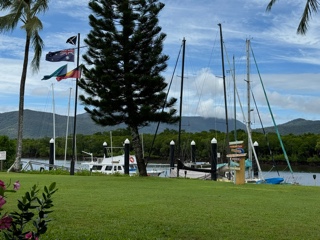 The view from our lunch table at the Cairns Cruising Yacht Squadron. All very civilised! We were up early for our flight to Yulara and were at Cairns airport for 5.45 am. There weren’t many people flying to Yulara at that time of day; only 12 of us boarded the plane. We didn’t really know what to expect when we got there but had no idea that Yulara would be a resort in the middle of nowhere. It was built in the 1970’s to manage the pressure of tourism on the environment around Uluru and neighbouring aboriginal cultural site Kata Tjuta. Everything there, including the airport, revolves around bringing tourists in, educating them about the area and managing the relationship between the visitors and the aboriginal people, for whom this is a sacred place. The first thing we noticed on landing was the flies! We were inundated with them, not the biting sort but little ‘house flies’ that were insistent on getting into your nose, eyes, mouth, ears, or just sitting on your clothing or bare skin. Thankfully we’d bought nets to put over our heads and our legs and arms were covered against the strong sun so we were able to put up with them. Apparently the wave of your arm as you bat the flies away is called the ‘Aussie salute’! We were pleased to learn that we had arrived just as the weather had become cooler. For weeks previously the daily temperature had been 43 degrees C whereas for the time we were there it was ‘only’ 26 degrees C. Surprisingly, the temperature dipped to around 8-10 degrees C overnight so the mornings were very cool.  Hat nets - a step up from the Aussie hat with corks attached and much appreciated. Had we known what adventure camping tours were like we probably wouldn’t have booked a second one so soon after our Kakadu National Park experience. However, we manned up and set off again, this time with a bigger tour group of 19 people, some slightly cleaner tents and a bigger monster truck tour bus. We were very glad we’d booked tents as the other option, the swag, was basically a roll mat on the sand with a sleeping bag you could zip over your head if it rained! I was anxious enough about snakes, dingos and creepy crawlies without lying down on the ground waiting for them to find me. I wouldn’t have slept a wink!  Our tents and tour bus, aka The Mothership 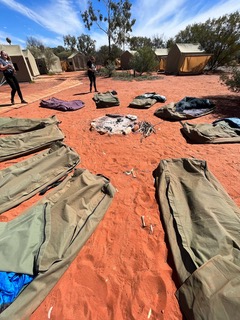 Swags ready for occupancy! Uluru must be the most photographed lump of sandstone in the world and it was every bit as spectacular in real life as it is in the photos. We saw it from every angle, including twice at sunset and once at sunrise. Its colour, the way the colour changes with the day and the way it rises so red from the vast expanse of flat greenery surrounding it makes it an awe-inspiring sight. Aboriginal people regard Uluru as a sacred place and they have stories from ’The Dreaming’ (creation time) associated with Uluru that date back thousands of years. We heard a lot about these stories though many of the actual stories are not told to non-aboriginal people. Several times our guide pointed to areas where we were not allowed to go or to photograph and said that it was a sacred area but we were not allowed to know why. I asked why were allowed to hear some of the stories and not others and was told that the stories we are allowed to know are those that are told to aboriginal children. Different levels of knowledge are imparted with maturity. The stories we were allowed to hear were either cautionary tales or stories about how the landscape was shaped by creator beings in the form of people, plants and animals. Although Uluru looks relatively smooth from a distance, close up you can see deep crevasses and caves at the base and higher up. Aboriginal people designated certain caves as places for men or for women and children. Rituals take place in these areas but we were not allowed to know what the rituals were or what they were for. We were certainly struck by how different aboriginal history and culture is from our own. John finds it difficult to believe that the culture is one of the oldest on earth and yet seems not to have progressed as other cultures have done. We had many discussions on what it means when we say a culture is developed, to which John’s usual response was ‘but they didn’t even invent the wheel!' 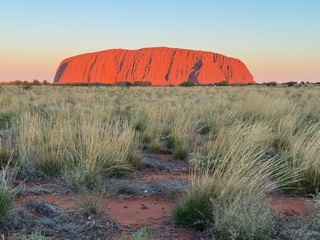 Uluru sunset 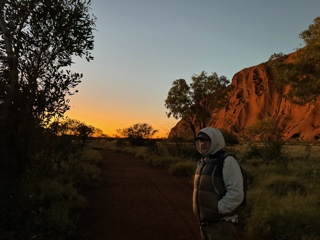 Uluru sunrise. Our tour guide dropped us off in the early morning darkness and we walked the 9 km around the base of the rock as the sun began to rise. 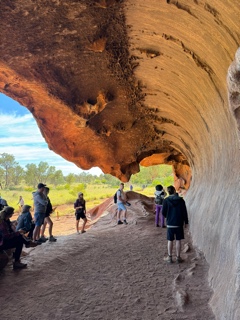 One of Uluru’s men caves From Uluru it was a 4 hour drive in the monster truck tour bus to Kings Creek Station, a cattle station complete with camels, from where we would get up before sunrise again to tackle the Kings Canyon Rim Walk. It’s only a 6 km walk but starts with a punishing climb up steep rocky steps before the trail flattens out to wind its way around the rim of the canyon. The birds eye views from the summit were stunning and there were some interesting fossilised rock formations. You could clearly see that we were walking on what had once been the sea bed, the rock pools and ripples in the sand were preserved even though we were 800m above sea level.  The 200m steep climb at the start of the Kings Canyon rim walk  Our tour group on top of the world.  Camels at Kings Creek Station. We saw some wild camels on our way back to Uluru but passed them too quickly to get a photo. An administrative error meant that we booked three nights camping but also a hotel back in Yulara on the third night so we had a clash of bookings. It seemed a shame at the time that the hotel booking was non-refundable so we couldn’t cancel it but it turned out to be a happy mistake because the tour ended for us in a hotel and not another campsite. The funny thing was that the whole tour group was dropped off at our hotel to have a drink in the bar before returning to camp and a surprising number of them turned up at breakfast the next morning. Having seen us checking in they’d decided that looked like a really good idea and checked in without pre-booking! So, a flight back to Brisbane from Yulara via Melbourne (there were no direct flights!) concluded our Australia/New Zealand adventure. As the crow flies we travelled more than 16,500 miles in planes, cars, trains, buses (and one motorbike) over four months. In Brisbane we now start to get Casamara ready to head north towards Indonesia. After a quick trip back to the UK we will start that journey at the beginning of June. 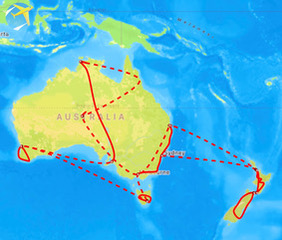 Our Australia / New Zealand land exploration route. |